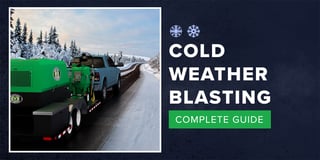Your Guide to Blasting in Cold Weather

Cold weather doesn’t have to put a freeze on your Dustless Blasting projects. With the right techniques and equipment, blasting in winter can be just as effective and profitable as during warmer months. Here’s how to keep operations running smoothly when temperatures drop.
Essential Tips for Cold Weather Blasting
-
Modify Your Water Tank: When temperatures dip to 32°F or below, add rubbing alcohol to your water tank. Start with a 1:100 gallon ratio and increase to a 1:20 ratio as it gets colder. This prevents freezing and ensures consistent blasting.
-
Warm Your Equipment: Create a tent around your pot, pump, and moisture separator using a tarp. This setup, combined with the ambient heat from the compressor, will help maintain optimal temperatures. Be cautious not to obstruct exhaust vents. For added warmth, consider moving operations indoors.
-
Switch to Dry Blasting: If conditions become too harsh for wet blasting, Dustless Blasting pots can easily transition to dry blasting. Learn how to make the switch to keep your project on track.
-
Stay Comfortable: Keep yourself warm and focused with the climate-controlled Nova 3® comfort system, which adjusts air temperature by about +/- 20°F from ambient conditions.
Handling Windy Weather
Blasting in windy conditions calls for extra precautions. OSHA advises against it due to the risk of spreading hazardous materials. If unavoidable, especially in the marine industry, use containment systems to isolate your blasting area. Adhere to OSHA's scaffolding safety requirements to ensure both worker and public safety.
"To do a 200-foot barge or tug in many places in Alaska, you have to contain. We use 6 mil reinforced poly sheeting."
-Mike, Dustless Blasting business owner
wet blasting in alaska: interview with dustless blasting machine owner
In this interview, we spoke with Mike, who restores large fishing vessels and barges in Alaska during the winter. Discover how he operates his equipment in these challenging conditions and continues to wet blast throughout the entire season.
The main takeaways:
- Protect the job site from the elements and blast debris by completely containing the area.
- Pumping heat inside the contained area to keep the surface temperature of the substrate at an optimal temperature for blasting and re-coating.
- Store your blast pot within an insulated utility trailer. Use an electric control box to prevent freezing.
- Wrap any blast hose that is exposed to the freezing elements with heat tape.
Winterizing Your Equipment
Protect your Dustless Blasting machine from freezing damage during storage by following these steps:
-
Open Ball Valves: Overnight, open all ball valves to prevent moisture from freezing and expanding, which could damage your equipment.
-
Drain the Water Pump: Run the pump until all water is expelled from the discharge to avoid freezing in the upper manifold.
-
Leave Media in the Blast Pot: No need to drain leftover media. Simply loosen the bolts on the flange at the bottom to allow any frozen water or media to be easily flushed out.
Winterizing Your Air Compressor
To keep your air compressor running efficiently in winter, consider these steps:
-
Consult the Manual: Start by checking the manufacturer's guidelines for winterization. Each model may have specific temperature limits and maintenance advice.
-
Regular Filter Checks: Inspect and replace air filters as colder conditions can lead to quicker clogging from condensation and debris.
-
Drain Regularly: Prevent corrosion and inefficiency by draining the compressor tank after each use. Adding a moisture trap or air dryer can further protect against moisture buildup.
-
Use Suitable Lubricants: Ensure lubricants are appropriate for cold conditions as viscosity changes can affect performance.
-
Insulate Air Lines: Protect the air lines from brittleness and cracking by insulating them.
-
Proper Storage: Store the compressor indoors if possible. If not, use a portable shelter to protect it from the cold. Disconnect power cables to ensure safety during storage.
-
Check for Leaks: Cold weather can exacerbate air leaks. Regularly inspect and seal any leaks to maintain efficiency.
For more on industries active during winter months, check out our blog on winter blasting jobs.
Cold weather blasting is not only feasible but can be profitable with the right preparation and techniques. Should you encounter any issues, our tech support is ready to assist. Stay safe and productive this winter season!


